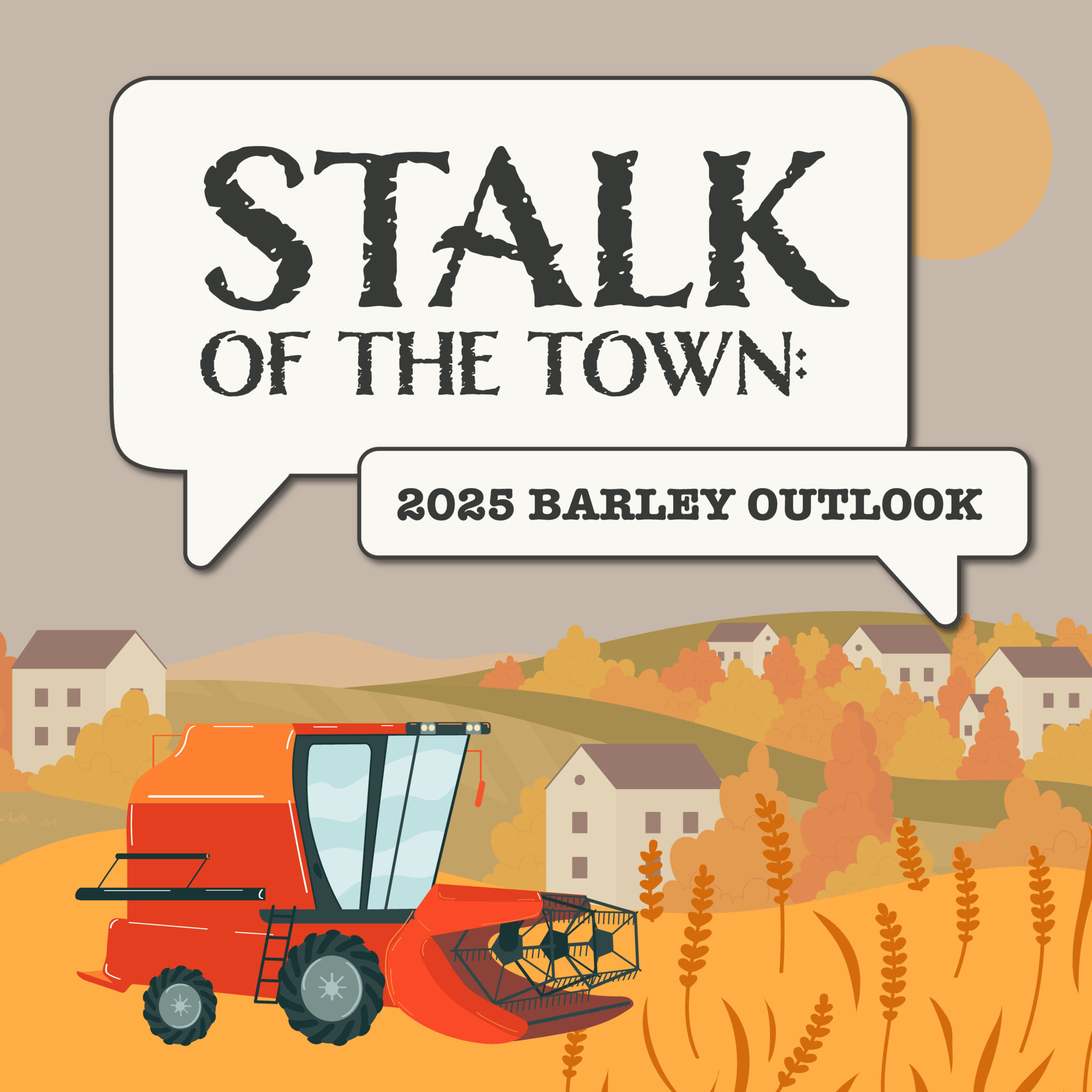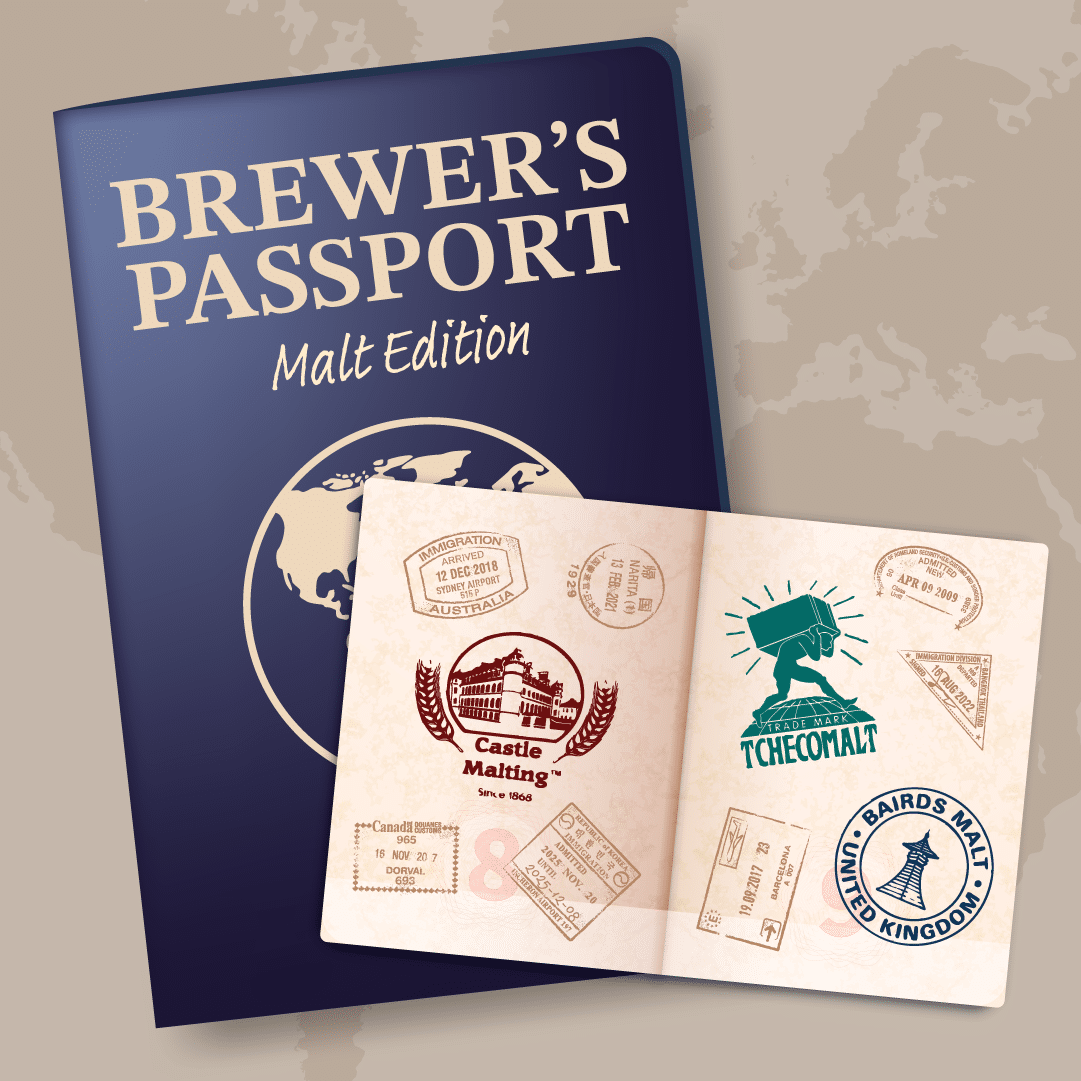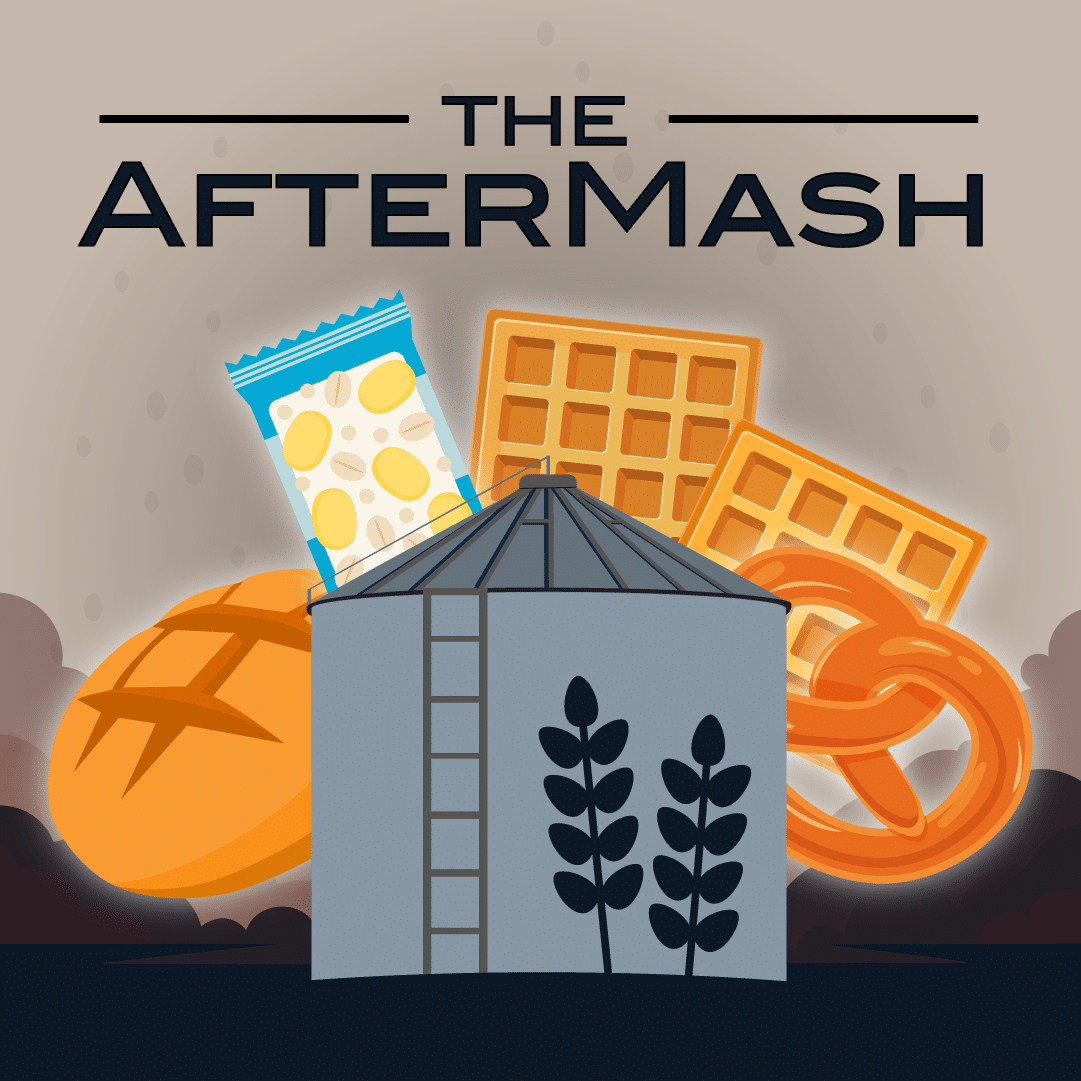
PODCAST GUESTS
Don Moore

Kyran Flett

MORE EPISODES
SEASON 2, EPISODE 19:
LITTLE MALT ON THE CANADIAN PRAIRIE
PODCAST HOSTS:
TOBY TUCKER – DIRECTOR OF SALES, COUNTRY MALT GROUP
GRANT LAWRENCE – TERRITORY MANAGER, COUNTRY MALT GROUP
GUESTS:
DON MOORE – CRAFT TECHNICAL SPECIALIST, CANADA MALTING CO.
KYRAN FLETT – NATIONAL SALES MANAGER, CANADA MALTING CO.
Key Points From This Episode:
-
How size and production of Canadian barley harvest compare to other countries.
-
General Crop Update: Similar production challenges around the world due to weather.
-
What production quality means for brewers and customers and what they should expect.
-
Why malt kernel size, plumpness, and other factors are critical in proactive priorities.
-
European Malt: Improves brewhouse performance and consistency to manage protein.
-
How barley is grown specifically for malt or feed varieties in Canada.
-
Supply and Demand: Why Canadian barley is the best if you can find it throughout the year.
-
How the elevator system shields volatility, segregates, blends grain for barley brewers, distillers.
Transcript - Little Malt on the Canadian Prairie
EPISODE S.2, E.19
[LITTLE MALT ON THE CANADIAN PRAIRIE]
[00:00:00] TT: Welcome to another lovely episode of The BrewDeck podcast. I’m your host, Toby Tucker, along with my buddy, my sidekick, my partner in crime, again Grant Lawrence. How are you, buddy?
[00:00:10] GL: I’m doing good today. It’s finally cooling off here in Houston.
[00:00:14] TT: I got to tell you. I woke up this morning, and it was about 65. I went outside, and there’s something about a good weather day that, man, it just gets the juices flowing, you feel good, you’re happy. You probably feel the same way.
[00:00:29] GL: Yeah.
[00:00:30] TT: On the flip side, if you go outside of Houston, it could be 65 and 150% humidity; just sweat your ass off.
[00:00:36] GL: There is that, but no, it’s just comfortable right now.
[00:00:39] TT: You know what else I’m excited about outside of the weather? Talking to these two gentlemen, we got on today. I’m just super excited. We’ve been trying to put this together for a while, but man, these guys are busy. They’re always out in the market honing the craft, educating customers, but really excited to have these two guys on. I don’t know about you, Grant, but I’ve been looking forward to this all day.
[00:00:59] GL: For sure. Yeah, stoked to have them on, two guys that really know their stuff and have been in the industry for a while. I can’t wait.
[00:01:06] TT: Damn right. Without further ado, let’s introduce them. In today’s podcast, we’re going to talk specifically about Canada Malting Company. Two of the stars, the movers and checkers over there. One of them is Kyran Flett. He’s the National Sales Manager at Canada Malting. Hey, Kyran.
[00:01:23] KF: Hey, how are you gentlemen doing?
[00:01:25] TT: Man, fantastic now that you’re on. Then we also got Don Moore, who’s a craft technical specialist with Country Malt Group. Some know him as ‘the Don’ or the Godfather. Hey, Don.
[00:01:36] DM: Hey there. How are you doing, guys?
[00:01:38] TT: He’s like, hey, how are you doing? It’s true. In the circle of Country Malt Group, Canada Malting, he is the Godfather, so super happy to have him on. Let’s go and get rolling, for sure. Again, in this episode, we’re going to focus on Canada Malting, some background on Canada Malting.
By the way, Canada Malting is under the umbrella of our malting company (if you will), along with Great Western Malting, which we’ve had those folks on before. I’m very excited to get rolling. Kyran, let’s start with you. Tell us a little about yourself, what you do at Canada Malting, and how you got into this business.
[00:02:14] KF: Sure. I’m actually sitting here in Calgary, Alberta, Canada. The leaves on my tree are about half on the ground. It feels like summer at night and gets down to about zero Celsius in the evening. The leaves are changing a little too quickly for my liking. I’ve been in Canada my whole life. I studied business at the university here. I went into grain grading. I did that for about five years and then transitioned over to the malt industry, and I have been in this role for about four years now.
I’ve worked with Canada Malting. We’ve been in that building now for about six years, and it’s just down the road from my house. It’s a fascinating industry. Agriculture as a whole has always been really interesting to me. Barley is a really interesting, unique crop in the world place. Then the malt is a very specific, even cooler aspect of that industry as a whole.
[00:03:08] TT: Yeah, that’s for sure. Ultimately, you are a fan of the craft beverage just like we all are, and that actually lends some added bonus to us being in this industry.
[00:03:18] KF: Yeah. I live in what we call the barley belt or the Inglewood kind of beer area. Within walking distance or biking distance—which everyone seems to do in this part of the city—I probably have eight breweries really close to me. Half of them, a lot of dogs, and I can even take my dog for an afternoon beer. I did with Don not that long ago.
[00:03:39] TT: Very good. Don, over you, buddy. Tell us a little bit about your background. You’ve had feet on the ground in a lot of different aspects of this industry. Tell us about how you got to where you are now and what you do currently.
[00:03:51] DM: I started brewing (I would say) one of the first craft breweries in Canada in around 86–87. From there, I had several breweries at that time, then got into a little bit of consulting, setting up brewpubs and breweries mostly in Western Canada. Some exotic places as well but mostly locally. Then I had an opportunity one day where someone from Canada Malting came into one of the brewpubs that I was working at or setting up and really enjoyed one of the beers that I had made and said, you should come work for us.
Lo and behold, a couple of years after that, he called and said the time is now. So I’ve gone back and forth between Canada Malting and Country Malt Group depending on the need over the last 14–15 years, something like that. That brings it to where we’re at today.
[00:04:37] TT: Do you still remember what that recipe is, or is it still in the market in some random can at another brewery or what?
[00:04:44] DM: No, it’ll still be made exactly the same way at a small brewpub here in DC. It was a Pilsner, actually.
[00:04:50] TT: That’s pretty awesome. Grant, in your prior brewing experience, you got a couple of recipes or beer recipes floating around in cans or on draft?
[00:05:00] GL: A lot of them were one-offs, but a couple of them were year-round for sure. I would say the main year-round one is a Martson. It’s like an old-style Oktoberfest, more ambery than newer ones.
[00:05:15] TT: I’ve had it. It’s fantastic. Needless to say, we have a wealth of knowledge here. Let’s get after it here. I think a lot of folks in the brewing community, in general, don’t really have a lot of knowledge of just the size and the breadth (if you will) of the Canadian barley harvest in general. The production and the sheer size of what happens in Canada on the barley size, as opposed to the US and other parts of the world.
Kyran, can you tell us a little bit about it? Let’s start with the 2021 harvest. Then also with that, a general crop update, and then maybe pepper in a little bit about the history of what you’ve seen over the years as far as the production in Canada, where we’re at ten years ago, and where we are now. I know that’s a lot to throw out, but there’s just so much we want to ask you.
[00:06:04] KF: I’ll give you a breadth of what we’re looking at this year, how that translates to typical years, and go from there. Typically, Canada produces about four times the size of barley crop that the US produces. About 50% of that is destined or grown to be going into the malt industry in some form or another, exports or domestic. The other half is for feed. We’re cattling here in Alberta.
That’s typical. Last year we produced about 12.5 million tons of barley in Canada. I had a great crop. Almost all the season was fantastic and didn’t have any huge hiccups. Then we transitioned to a year like this year. Since my entrance into this industry, I haven’t seen production this low or this challenged.
We were estimating about 12.5 million metric tons in April, and that is said to be about 7 million times here. We just wrapped up harvest probably a week ago. There are some stragglers here and there, I’m sure, but 95% of the barley is in the bins now. All the malting barley is in the bins now.
We had a really low protein, nice and plump year last year, but going into this harvest just due to weather, we see higher protein, a little bit thinner barley. That really happened because over the winter, where typically we have a lot of snowfall on the acreage that grows barley. We had a really warm, dry winter. We had long, sunny days of exposure, so the ground was exposed. There was no snow, and the wind and sun sucked out the water.
We got a bit of water and spring, and things are looking really good. The barley crop was in early, which is always very key in Canada, especially in the northern altitudes that we’re growing where snow and frost come in September real quick.
We’re very excited. A lot of acreages went in. It was early, got some moisture in spring, and then didn’t see a drop of rain for about a month during the hottest period of the growing season, which was mid-June to mid-July.
We had the most over 30 degrees Celsius days that we’ve ever recorded in Alberta and Saskatchewan. It was hot, long sunny days. The plant grew well and quickly at first. Understand that the water and the moisture wasn’t there and adjusted itself accordingly.
[00:08:22] TT: Ultimately, what you’re saying is, I guess, the one word to describe what’s happening. Let me back up here. It’s not just in Canada. The US is experiencing very similar challenges if you will?
[00:08:35] RF: Yeah. They didn’t lose almost half their crop. They lost 20%–25%, which is still huge. Last year, North America produced (let’s say) 16.5 million metric tons, and that’s down to 9 million metric tons. Overall, North America is very challenged. A lot of those protein levels that you can’t use, thin levels that you can’t use, and it has to go to feed and not to malt.
[00:09:04] TT: I’m glad we’re having this conversation. It can be very honest as far as what’s going on. I think probably one thing that brewers aren’t hearing from a lot of producers is really what their quality is going to look like. I know Canada Malting has done a great job reaching out and educating brewers on what to expect, being very upfront of the concerns with the tonnage, and what both Canada and the US look like as far as production. But when you’re talking to brewers, what does that mean when we have a very challenging year like this? What does it mean for the brewer?
[00:09:39] KF: Obviously, you can hear all these large numbers and what’s disappearing, what’s there, what’s not. At the end, when I talk to my customers, what is it going to change for them? I’ve been trying to be really honest that this year’s crop isn’t going to look like the last few years’ crop, both in terms of pricing structure as we go into 2022–2023. But also, your quality, even if you were able to blend and utilize pockets of lower protein, your overall quality will slightly change going into the next year.
As I see it, a really tough year like this year takes 1½–2 years to recover when you have an island of production where Canada and North America have some of the highest protein, best in genetic barley in the world. That demand cycle doesn’t just subside right away. You usually say that you’re going into next year with well-above-average pricing.
If a big production comes off the next harvest, then that can correct a lot of this. But if there’s any hiccup and delay in planting or whether at harvest, the cycle continues on. I think there will be a lot of barley acres next year in North America, a lot of malt acres, which is great. It’s very supportive in the industry, but it will take some time for that to come back down.
[00:10:58] TT: I just want to reiterate here. It’s not just a challenge with Canada Malting or Great Western Malting. I think the entirety of North America, regardless of what producer you’re talking about, is going to see the same challenges across the board. Maltsters, especially those at Canada Malting are very talented individuals that have to take what they’re given and try to make a consistent quality product that the brewers use every day.
Obviously, we’ve got some faith internally with Canada malting and Great Western for that matter, that they’re going to do the absolute best they can to do what they got to do and change strategies in the malt house to come up and continue to provide that quality product.
Hey, Don, jumping over you, too. When you talk about what a challenging year as far as the barley crop is concerned for brewers, they’re obviously going to have to take a look at maybe potentially how things turn out, but their regimen at the brewhouse. Is there anything that you would suggest proactively taking a look at or thinking about prior to when this new crop starts rolling out?
[00:12:03] DM: Yeah, absolutely. I think if we look at the malt kernel itself, it will probably be less plump than in the past few years, so sizing will be critical. I think it’s important that the brewers this year really stay on top of their COAs, keep an eye on their plumps, make sure they have some seeds available that they can check their gaps on their mills all the time to help with lauter ability because it’s probably not going to have as plump malt as they typically do year on year.
Those are starting points for sure. Other things that could be considered for the brewer would be to use rice hulls to aid in lauter ability. That’s always a good thing, depending on the depth of the mash that a lot of the brewers are using. If they have challenging lauters anyway, certainly it will be helpful this year.
Enzymes potentially, but we’re not sure yet. We haven’t really fully assessed the quality of the malt into the malthouse yet, but potentially enzymes upfront if that’s something that the brewers are comfortable in using, products like Clarex, stuff like this in the fermenter to aid with any excess protein. That’s what I would think.
[00:13:09] TT: Grant, as a brewer yourself, did you have to go through periods in your brewing tenure where you’ve had to make adjustments in house to change as a crop? Was there any particular year that stood out? What regimen did you guys have?
[00:13:24] GL: It’s tough to say because we’ve had so many good years. This thing doesn’t happen that often, thankfully. I think a lot of brewers are going to be looking at their COA this year, probably more than they have in prior years. I would say the last time that there were similar to this is probably back in 2014–2013 when there were some more things and people really needed to do sieve analysis and check it.
If you’re out there listening, it doesn’t matter where you’re getting malt from. If you’re getting North American barley this year, get ready. Just review everything, make sure your sieve sets are in order. You’re probably going to need it.
[00:14:00] TT: Yup, absolutely. I guess this leads to another pointer question. The question, Don, we’ll start with you. The word is that the crop in Europe is fairly decent, right? You had made some comments previously that it might be worth looking into just feathering in some of that European malt.
[00:14:21] DM: I’ve tried 25% European collusion. Personally, I would go with a lower color, more neutral flavor to European malt. My personal favorite is the best malt, Heidelberg, for that purpose because it disguises everything, but we’ll certainly help with brewhouse performance and consistency through the year. That would be a starting point as well, for sure.
[00:14:45] GL: I think that’s a great call out. If brewers are looking at slightly elevated proteins this year that are used to fooling North American malts, I’m just going to go ahead and toss in like […], something that has a much lower protein to blend in like Don’s saying.
[00:15:01] DM: Yeah, even just a […] from England as well or Scotland if you’re making mills. Certainly, on the lager side, something like the best malt would be perfect to aid in consistency. It helps bring that higher protein that the brewers will be receiving down to a more manageable level within the brewhouse and help provide consistency throughout the year.
[00:15:22] TT: Going back to what you mentioned. Did you say 50% of all barley crop, give or take, going to the malting side, the other is going to feed? Two questions: Is some barley grown specifically for the feed market, or is 100% goal of these growers to try to increase their yield and profitability to be able to sell it into the malthouse, and then some passes muster, some doesn’t?
Secondly, the other challenge that I’ve heard about maybe expanding upon is China, and other countries are looking for feed barley. Is that putting a strain, or has it put a strain on actual availability in North America for malting barley?
[00:16:03] RF: Yes. In Canada, we still grow two distinct varieties, feed and malt varieties. If you go to Australia, they actually grow only malting varieties that have yielded closer to what that feed varieties are.
In Canada, when we think about our growers, we want growers who have grown malting barley are willing to sacrifice time, and spray at the right times, harvest at the right time. Because again, if you leave this malting barley in the field too long at harvest, you get any moisture, you start to get some pre-germination.
This stuff is ready to germinate as soon as water hits it, once it gets into the malthouse. We really pull out the best malt growers that we can, and we don’t usually look for someone who’s growing feed year to year and then just wants to switch over to malt. It does require a lot more effort; it’s a more costly seed.
We have two distinct growing regions, and there are a lot of farmers that maybe will grow both, or there are a lot of farmers that will grow a bunch of malt barley. If some of it gets rejected or doesn’t make it into the malthouse or for exports, they can still have a good domestic market in Alberta or in Saskatchewan for feed. They go hand-in-hand. The feed market really helps support the malt market because there needs to be a […] if it can’t make malt […]. They go hand-in-hand, but they are very distinct.
Then we look at exports. Eight years ago, Canada wasn’t exporting a lot of barley. That number continues to rise and rise mostly to China. That’s grown both in feed and malt. Last year, China took probably 1.5 million tons of malt barley, over a million for sure.
That’s great for our industry in many ways because it means a better price to the farmer; usually, it means more outs for the farmer. It means a supported acreage of malt, but it means that when there’s any challenge, or there’s not enough stock left, that can challenge the industry as a whole, and that can make it a bit tougher for us to find malt barley.
It’s a gift and a curse when you have a commodity like Canadian malt barley, which is now viewed worldwide as the best barley. It’s usually two points higher on average on protein than any other growing region. It’s got amazing enzymes. It’s a great product.
But that means that sometimes, we have a harder time finding it throughout the year, and prices can elevate due to the strong demand worldwide for both barley and malt. North America obviously uses a lot of Canadian barley as malt. We have a couple of great malting companies here that send a lot of malt down to the US as well and to Mexico.
[00:18:39] TT: Yeah, that’s all good points there. We’ll talk a little bit about Canada Malting and some of the armor that they’ve had, specifically in their elevators systems here in a second, which help shield some problematic years, pretty substantially compared to some other folks. We talked about this new crop. When can a brewer expect the new crop to start making its way into bags, totes, or even on the bulk side? Do we have an idea yet?
[00:19:05] RF: Yeah. We’ve run batches across all three plants in Canada. We’re doing analysis now. We’re building up inventory. I would expect a bagged product within four weeks. That will start to hit the market. All customers were already looking at two weeks at certain plants.
We’ve tried to make sure that communication is going from our team outwards. If there are any large changes between specifications, we try to make sure that that information is very accurate. We try to make sure everyone is aware of what changes are coming down the pipeline in regards to quality.
[00:19:41] TT: Going back to the elevator systems, Grant, have you had a chance to visit any of those up there in Canada yet?
[00:19:46] GL: I have, yeah. I’ve seen Beiseker. I’ve seen that elevator. It’s pretty amazing.
[00:19:52] TT: It really is. Yeah. I don’t think a lot of people know about the elevator system. We’re very proud of having CMC and obviously having that in our portfolio. But one of the things that set you guys apart, and specifically again, helps to shield some of that volatility year to year on the barley crop. Kyran, tell us a little bit about this elevator system and what it means for Canada Malting and ultimately for the end-user, which is the brewer and the distiller?
[00:20:21] KF: For sure. Grant’s seen it, which it’s funny when you say you got nine country elevators across the prairies. People think of these big, concrete, or steel elevator systems, but we actually have smaller segregation-based elevators. In the small communities, they’re older, but they’ve been refitted by us to handle malt barley. We can have anywhere from 50–100 small segregations at every one of these elevators. That means a single variety of barley, a single farmer’s barley, is going into this segregated bin.
We then ship that to the plant as segregated malt everything together. We can have a homogeneous product, and we can make sure we’re consistent. We’re not blending different varieties, different proteins. Then, in the end, we can blend what malt is needed to give the most consistent product for the brewer.
[00:21:15] TT: The other thing—you’re going back to it—the other positive is that you guys are within a very, very short distance of the growers. You have that boots-on-the-ground relationship with them, and they don’t have to go very far to deal with you and shake hands and get that grain in the bins, right?
[00:21:32] KF: Exactly. We have employees that are living in these communities. I have been buying from these different families for 10, 20, 30 years. They have these relationships. They live just down the door. They can get samples to the elevator right away.
We’re very proud of them, and they are a strong part of why and how we do what we do. It’s a wonderful, great team, and I love showing them off. I think they look beautiful as a backdrop against the prairies. Anytime any brewers that are listening to this are in Canada when that’s viable again, we’d love to show them off and see what they’re all about.
[00:22:06] TT: I will say, historically, you guys are always putting on a fantastic, what we call malting course, but it’s basically bringing some folks up, visit the malt house, take a run, walk around in some of the fields, and a little beneficial plus of getting up the bath and stuff like that. I can’t wait to be able to do that again, for sure.
[00:22:22] KF: Yeah, and we’re hoping next August to have that back. We’d love to see a huge amount of US and Canadian brewers come out and do it again as we have been in the past.
[00:22:34] TT: Absolutely. Grant, I know you’ve just been itching to talk about specifically some of these unique products that CMC has. I’m looking at this list of questions that you wanted to ask, and we only have a short time. We don’t have a day, but have at it, buddy.
[00:22:52] GL: I want to go one more question about the elevator, just something I’d like to reiterate that Kyran mentioned is when you can segregate raw barley into these bins like this and then move them to the malthouse together, you can malt light for light barley. When I first heard about that, a light bulb came on my head is really from a malting standpoint. That’s the best way to drive consistency, and at least no other North American maltster I know of can really pull that off because they don’t have the elevators for the segregation.
[00:23:22] KF: I think you can equate it as well as a brewer. The more fermenters that you have, the more flexibility you have from your brewhouse with the elevators. The more bins we have, the more separation we can do. The more it helps the malthouse upstream.
[00:23:36] GL: For sure. I want to jump back into the products that Toby mentioned. A lot of them don’t make it down here stateside. I’ve done a few collab brews with some different brewers about it, but I was hoping for our listeners out there. Can you guys walk us through some of the (I guess) relatively Canada-only malts that you guys make? The Alberta Heritage Select really comes to mind.
[00:23:58] DM: We make a bunch of specialty products. Depending on their usage, it’s basically where they’re located. Sometimes the brewers are asking for something specific like Alberta, where we had a lot of the Alberta brewers coming to us saying, hey, look, we’re in Alberta where we grow a lot of barley. Can we have a specific Alberta barley? So we produce that with 100% Alberta inclusion for the brewers there.
Sometimes it’s actually for tax incentive reasons, wherein certain states or provinces, the brewers or distillers will get a tax benefit from the government so that we’ll use products exclusively from those particular areas for the brewers or distilleries in that region.
A good example of that would be the BC Select, where we have that from specific BC barley that’s produced for the brewers and or distillers in BC where I live, as well as we have Empire malt that we sell into New York, where we procure barley out of New York State, bring it up to Montreal and malt it, and then sell it back to the brewers in New York, so they get a benefit from a tax incentive as well. The same thing would apply to the Quebec barley. We use all Quebec barley to produce malt for the brewers of Quebec, as well as the Maritimes.
Each region gets specific stuff, and our malthouses are nimble enough that they can handle this and keep it basically segregated and separated very much as you would have for an organic product. The product integrity is maintained throughout, and each region gets what is specific to them and what they like.
The Quebec malt and the Maritime malt is more like a pale ale malt, a little darker in color, a little deeper in flavor than (say) the BC malt, which is more like a Pilsner-style malt because that was more of what was requested from the brewers in that region. That answers your question, I think.
[00:25:50] GL: Yeah, perfect. Very cool. BC Pilsner sounds lovely.
[00:25:55] TT: You mentioned the special kind, like a pale malt. I want to get back to this, and I’m sure Grant wants to as well. We will let someone talk specifically about the CMC Pale Ale. It’s a unique product that not a lot of people know about and will probably be interested to hear. Tell us about the red wheat you guys are producing now.
[00:26:11] DM: We had an opportunity to get some number one or grade one red wheat, which is the highest quality that you can get. I think it’s through a relationship with one of our members of the grain team and a farmer that he had met. We looked into it, and we had some requests for it in the past. Actually, red wheat is the predominant wheat that’s planted on the prairies. It isn’t actually white wheat which a lot of people think.
We decided because we already had white wheat in production, what could we do to differentiate the red wheat? What we did was we sourced a higher protein wheat. We thought if we could try to keep the color as low as possible, so generally, there’s always a tag team when you increase protein, it’s hard to keep color down, but to try to keep it as low as possible so that the brewers that were asking for wheat specifically for hazy beers or head retention, you’d actually add more wheat and not pick up the color associated typically with higher protein levels.
That sort of was missing, why we went with the red wheat. It’s been a huge success, actually. Everyone who tries it really loves it. I know that there are brewers who swear that it tastes better than the white wheat, and there are brewers who swear that the white wheat is more flavorful than the red. I brewed both ways, and I’ve never really noticed a significant difference. Really what you want in your brewhouse and the purpose that you’re using it for is the selection point that I would use.
[00:27:41] TT: Grant, I know you and I both ran into customers and our trips together that swear by that they can taste the difference between the red and the white. To each their own, but you’re absolutely right. It’s a fantastic product, absolutely.
[00:27:54] GL: Yeah. Red wheat has an interesting history here in Texas because it’s quintessential to the Belgian white or wheat beer style. At least, the people that are in the know say that, so they’ve always sought out red wheat over the years. Ever since CMC has rolled out with this new one, it’s just been extremely well-received. There just weren’t that many options for malted red wheat. This is just another one. It’s really neat to hear that it was malted, especially for a higher protein, something that’s just perfect for a wheat beer style.
[00:28:23] KF: It’s an easy IPA as well, that type of thing.
[00:28:26] GL: Yeah.
[00:28:27] TT: For the listeners—just shameless plug here—we do have that product peppered around our DCs in all of North America. If you haven’t tried it yet, give it a whirl. Let us know what you think.
We’ve talked about kind of the specialty regional Canadian malts, Don, but what about the other unique product that’s not new really, but really just took off specifically when the hazy started hitting the market, and it’s still a very popular product for Canada Malting is the oat malt. When did you all start first bringing that to market?
[00:28:57] DM: It was after one of the craft brewer conferences, I think, that we had been contacted by one of the larger craft breweries in the US. I think they came to us and said, do you have the ability to produce malt and oat? We did, so we got to our grain team and saw if they were able to procure what we needed. We ran a bunch of trials in our small maltings in Calgary. Everything turned out promising, and then we moved forward with it after that. It has taken off certainly beyond our expectations at this point.
[00:29:31] GL: I’d say it’s like the core ingredient for a lot of people’s hazy beers at this point. It has just those right-sized proteins for keeping a stable haze. I’ve turned a couple of brewers on to it. I brew with myself. It’s an awesome product. It’s still relatively new in the malting world. Good call out, definitely something people should try if they never tried an oat malt before.
[00:29:54] DM: I think that one of the discussions that were early on was whether to keep the husk on or not. One of the challenges of the malted oats is they actually have to be treated or cleaned and whatnot before they get to the malt plant. Actually, at the malt plants, all our cleaning machines there are made to take oats out. They actually have to be cleaned and set off-site before they come into the malt plant. It has its own pathway to be separated. The idea of keeping the husk on was something that we wanted to do for a few reasons. Notably, we find that it’s a more stable product. It doesn’t tend to change its flavor over time.
The husk integrity and how that helps with lauter ability, particularly if you’re using a high percentage, we think, is absolutely a plus. The only thing that the brewers have to really be aware of is the fact that it’s a slightly small kernel size compared to malt barley. Oftentimes, adjusting the mill or getting pre-milled oat malt would be necessary for them.
[00:31:00] TT: I think the other thing they need to be aware of is trying to chew this stuff and breaking it, cap over the tooth or something. I remember when it first came out, Don, I went after it, just like a wood chew on malted barley. I was very surprised and had to immediately go and make an appointment with my dental hygienist.
[00:31:20] DM: Oats by themselves, if you look at historical oat beers, would have been stouts and whatnot that had malt in them, and tend to have that silky smooth character, which once it’s malted and gone through the mashing process, it certainly has. But when you’re just chewing on a kernel of oat malt, it’s not the most pleasant thing.
[00:31:41] TT: That’s right. You talked a little bit about the difficulty in the malting process, but as a brewer, any specific considerations on how to use them or what inclusion rate on the recipe? I know it depends on the recipes, but what do you see that inclusion looks like as far as the recipe formulation?
[00:32:00] DM: I’ve talked to some guys that use it as high as 35%, but I don’t think you need to go that high. I was talking to a brewer just this past week, actually, and he was using 20%, and he’s cut it (I think) about 13 or something like this. It’s still working to the benefit that he needs in his brewhouse.
I think when it comes to oat malts and how they work in your brewhouse with your water composition, how they’re going to form a haze, it kind of varies from brewery to brewery, and everyone’s going to have to experiment themselves on what combinations are going to give the best results.
Some guys will use malted oats so they can have husk integrity in conjunction with flakes. Some guys will just use the oat malt by itself without any flakes. It really depends on the brewer what their long-term intention is.
[00:32:48] TT: I’m glad you mentioned flakes. It’s one of the most common questions we got when it first came out. We still get it, Grant. I know you probably do, too, but if somebody is using flaked oats, pregelatinized stuff, what’s the major difference between the two, and how can the CMC oat malt differ and improve their current recipe?
[00:33:10] GL: I would say flakes don’t have a husk. So if you load up a recipe with them, you’re probably going to need rice hulls. In one way, it’s nice just to have the husk-like Don was talking about still on the malted oats. Then number two is a flake adjunct is cooked. There’s no diastatic power. Malted oats still have diastatic power. They can convert. They’re just more fermentable, so you get more bang for your buck from extract per dollar standpoint as well.
[00:33:36] DM: I think you’re also going to get the added flavor. The actual kilning process when you’re adding heat to it does provide additional flavor as well.
[00:33:44] GL: For sure. When you go up to, like you were saying, 30%, you can almost get this nice little oatmeal cookie. You know it is great.
[00:33:51] DM: Yeah, granola.
[00:33:52] GL: Granola, yeah.
[00:33:53] TT: Canada Malting Company has just a great portfolio. It has really solid products. Superior Pils is obviously just tremendous. The Munich malt as well, just really good stuff. I think one of them that I think gets overlooked, maybe not in Canada but down here in the US, is the Pale Ale that you guys produce. Let’s talk about that one a little bit. Do you know any of the history of that particular product and what it was developed around?
[00:34:17] DM: I do. First, I’ll say some of my most favorite beers that I drink are made with that malt exclusively. Shout out to all the guys that are using it. I know that back when I first started with Canada Malting. We saw a lot of increase in pricing with European malts, in particular, […]. So we decided at that point in time that we should look to see if we could do something domestically that could offer a competitive cost advantage to the brewers, but yet still have the same malt characteristics that an English malt would, but allow them to get their brew costs down per brew.
That was the original impetus behind it. I’m sure it was all discussed over a beer at some point in time. As […] as a sister company of ours, I don’t think it was too difficult to make a real ale-like product with an American varietal. At the start, I believe we ran exclusively with Metcalf as a single varietal, but as Metcalf is basically in decline on the prairies, that had to subsequently change down the road.
It’s a wonderful malt. It’s got a great flavor, and in my personal opinion, I think it tends to dry out a little bit more than you would get from a European comparable. That tends to accent or emphasize the hop character that the brewers are looking to get a little bit more, perhaps, without leaving that additional sweetness. That’s what I would say about that.
[00:35:40] GL: I think that’s a great call out. It’s definitely a malt that was more popular a few years ago. It just seems like brewers, in general, have gone to using lighter color base malts. I think sometimes that’s a mistake. I really hope that some people out there listing will give CMC Pale a shot because it’s delicious. If you’re making any kind of UK-style or just a classic, I make IPA clear again. IPA, you just can’t beat it.
[00:36:07] DM: I know that when I was doing consulting. I also found it to be the ultimate breakfast food. You’re just going to grab a couple of handfuls, maybe mix it with a bit of Munich, and you’re set for the morning. It’s got a great full flavor, just like Maris.
[00:36:21] TT: You mentioned the color. I think generally that ranges like 2735, so it’s not a massive color change, but it is a really good product for sure.
[00:36:32] DM: I agree. I use it everywhere that I go; when I was setting up breweries, back when I was consulting and whatnot, I had great results with it.
[00:36:41] TT: Don, what’s in your beer fridge right now? What are you enjoying? I know you’re a connoisseur. As mentioned before, you traveled many a place and tried many a beer. What’s in your fridge right now?
[00:36:53] DM: I just got back last night from Vancouver, where I was doing some crop reports with Heather there. My son had come over for dinner, so there was actually nothing in my fridge when he got home. But I stopped at a friend’s place on the way home because, after a four-hour drive, I did want to have a beer. He happened to have some cold Hoyne Pilsner.
I’m a Pilsner junkie, basically. Whenever I’m on the road with the territory managers, they know that I’m always trying to go to the very best Pilsner brewery in whatever region that I happen to be in. That was a delicious Pils last night, but to be honest with you right now, I’ve been on a bit of a Mezcal thing. There’s a series called Alipus. It’s an artisanal Mezcal. There are nine different ones in this particular series. I’ve been trying to work my way through those, and they’re just delicious.
[00:37:43] TT: Man, I’m a fan of Mezcals. My wife doesn’t have too much there. They’re so good. You make the right cocktail. Out of them, it’s even better. So going back, did you disown your son?
[00:37:52] DM: It’s funny. I actually have one son that owns a brewpub, and he actually doesn’t drink beer. My oldest son, he does, but he’s not in […].
[00:38:15] TT: Cool. Grant, anything else you want to fire? It’s a rare occasion we get Don’s knowledge and can ping some stuff off him.
[00:38:25] GL: It is. Have you brewed anything? Do you collaborate with one of your folks or anything like that lately, Don? Pils, maybe?
[00:38:32] DM: I haven’t, and I’ve been seriously considering firing up my old homebrew system again. I’ve had a hankering just to get back into it. There are some new products that I would like to try and play with myself, a lot of new hot varietals that I’m not 100% familiar with because I don’t get to use them. So I want to get back into that and play around a bit. I know that there’s a bunch of guys on our team that homebrew as a hobby, and it’s fantastic. I might just jump back in.
[00:38:59] GL: I don’t get to as much as I used to homebrew, but I know that you’re a big lager fan. At least for me, right now is a season for Oktoberfest Dunkel. I just made a Dunkel the other day with the new BestMalz roasted that we’re bringing in. It turned out perfect.
[00:39:17] TT: That’s wonderful. I’m excited about that product. I guess you’re opening the box a little bit for a future episode, but we’ve been waiting on that stuff from BestMalz for a while. They’ve dialed in what they’re doing. For listeners out there, you want to learn more about these three roasted products we have coming in soon from BestMalz. Take a listen in a couple of weeks. I think we’ll be chatting with the folks at BestMalz about those.
[00:39:38] DM: I know that the tasting that I’ve had, samples that I’ve tried, those dark malts, they are fantastic. I am also excited about them—a different method. We’re not going to give away everything, but it’s a different method of producing dark malt.
[00:39:52] GL: That’s right. We’re going to plan a future episode on that one here in a few weeks. We’ll come out with that. We’re getting our ducks in a row for it, but it’s going to be good.
[00:40:00] TT: Yeah, absolutely. Guys, I really appreciate it. Don Moore, craft technical specialist with us at Country Malt Group with some history at Canada Malting there as well. Then Kyran Flett, who’s the national sales manager over there. A real pleasure having you guys on, and obviously a wealth of knowledge.
They’re always open to chatting with brewers. That’s what they do. That’s what they love. So if you want to toss around some questions our way, shoot them to me, shoot them to Grant, shoot them at Country Malt Group, and even Don. We’ll make sure they get in the proper hands.
For the products, we talked about the unique CMC stuff, the oat malt, the pale ale, and the red wheat. We’re stocked and ready, so reach out to this, and we’ll certainly send some your way. Don, Kyran, thanks for your time today.
[00:40:41] DM: Yeah, you’re most welcome. One final thought. Guys, stay on top of your COAs this year.
[00:40:47] TT: That will do it. Absolutely. All right, Grant Lawrence, our South Central Territory Manager. Always a big thanks to you. You’re a big contributor to these things, and I couldn’t do it without you. Thanks so much.
[00:40:59] GL: Yeah, man. Good being here. Don, I hope you come back down this way soon, and we can crush the Pils and maybe grab some Texas barbecue together.
[00:41:06] DM: Yeah, Louie Mueller’s.
[00:41:07] GL: That’s right.
[00:41:09] TT: All right. Thanks to everybody for plugging in with us today. We appreciate it, and we’ve got some great episodes coming up. Wherever you’re plugging in the podcast or subscribing, or hell, I don’t even know what they do, but just make sure you’re listening. We look forward to talking to you soon. Thanks from The BrewDeck. Cheers.
[END]












